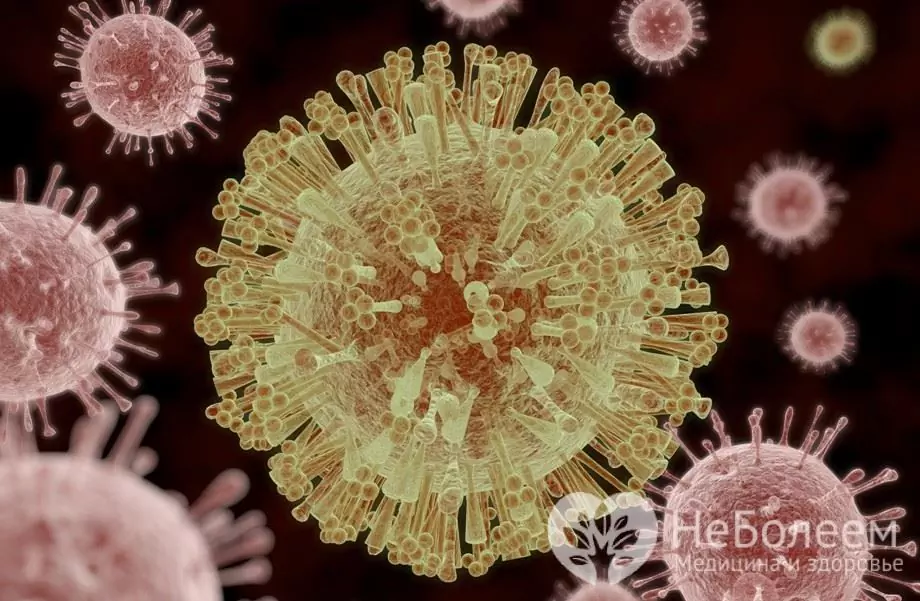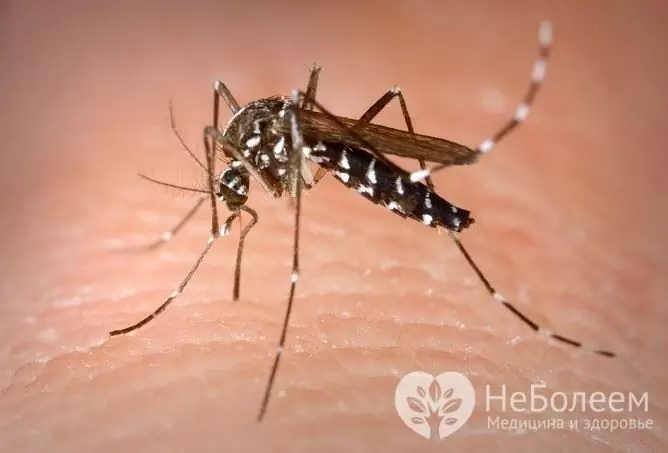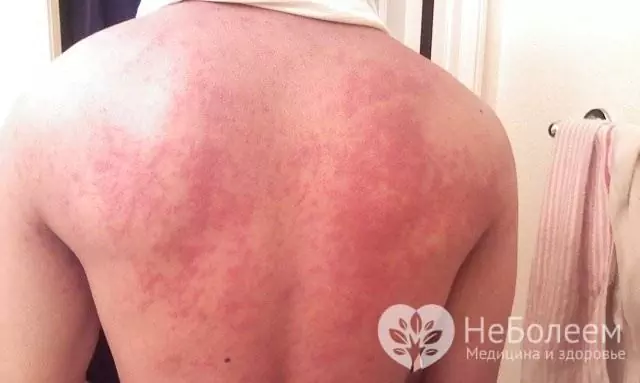- Author Rachel Wainwright [email protected].
- Public 2023-12-15 07:39.
- Last modified 2025-11-02 20:14.
Zika virus
The content of the article:
- Features of the spread and transmission of the Zika virus
- Forms of Zika fever
- Zika Fever Symptoms
- Diagnosing Zika Fever
- Zika fever treatment
- Possible complications and consequences of the disease
- Forecast
- Prevention of Zika Virus Infection
The Zika virus is a spherical arbovirus with a diameter of no more than 40-45 nm, belonging to the Flaviviridae family, which, when ingested, can provoke a disease known as Zika fever.

Zika virus is a spherical arbovirus
For the first time, the Zika virus was isolated from the blood of rhesus monkeys in the tropical forests of Uganda in 1947, hence the name ("Zika" in translation from the language of the local indigenous population means "thickets").
The Zika virus was detected in human blood 5 years after its discovery, amid outbreaks in Nigeria, Tanzania and Uganda. Over the next years, epidemics of Zika fever were periodically recorded in many countries of the African continent (due to the existence of optimal living conditions for the carrier of the Zika virus: hot, humid climate).
It is believed that the spread of the Zika virus eastward across the Pacific Ocean began in 2007, reaching South and Central America, some regions of India, French Polynesia and other territories in 7-8 years. Currently, isolated cases of the disease are reported in some European countries.
The largest Zika epidemic on record began in 2015, spreading to more than 30 countries and regions on both American continents. According to some reports, in Brazil alone, the number of infected has reached one and a half million. The World Health Organization has announced 3-4 million people who have had Zika virus infection, as of the end of 2016, the disease was recognized as a pandemic. Zika is currently officially recognized as an international public health threat, despite the fact that the potential of the virus has not been fully understood.
Features of the spread and transmission of the Zika virus
Carriers of the Zika virus are tropical mosquitoes of the genus Aedes, the causative agent of the disease enters the human body at the time of a blood-sucking insect bite.
The bulk of arboviruses migrate between animals that are their main hosts and blood-sucking arthropods. A person in typical cases of arbovirus infections is a dead-end branch for the development and reproduction of pathogens, since the concentration of viral particles in his body is insufficient to release into the external environment in significant concentrations to infect others. The Zika virus (along with a few other pathogens of tropical infections) is an exception to the rule in this regard, since it reaches high concentrations in the internal environment of the human body: it is determined in blood, urine, saliva, seminal fluid, cerebrospinal fluid, amniotic fluid.

Carriers of the Zika virus - tropical mosquitoes of the genus Aedes
To date, the following routes of transmission of Zika virus from an infected person to a healthy person have been reliably confirmed:
- with transfusion of infected blood (the danger lies in the long incubation period of Zika fever, when the donor does not know that he is infected: in some cases, the symptoms appeared in donors 1-2 weeks after they donated blood);
- during sexual intercourse (and no cases of Zika virus transmission from women to men have been reported);
- intrauterinely from an infected mother to the fetus.
Of particular concern is the vertical transmission of Zika virus infection from mother to fetus.
During the epidemic that began in 2015, only in Brazil, according to some sources, there was a 20-fold increase in the birth rate of children with CNS pathology, mainly microcephaly (abnormally small size of the head and, as a result, the brain).

Mother-to-fetus transmission of Zika virus is at high risk of having a baby with microcephaly
Some children exposed to intrauterine exposure to the Zika virus have seizures, dysfunction of the structures of the brain stem, pathologies of hearing and vision, and other neurological abnormalities. Collectively, congenital abnormalities associated with the influence of a pathogenic agent on the fetus during pregnancy are known as congenital Zika syndrome.
In the countries of Latin America, the leadership of some states officially recommended that couples planning to have children to give up pregnancy until the epidemiological situation improves.
Forms of Zika fever
The infection proceeds in several forms, depending on the severity of the process:
- asymptomatic;
- easy;
- moderate severity;
- heavy.
More than 2/3 of all cases of Zika fever are either asymptomatic or in an erased form.
The severe form of infection caused by the Zika virus is extremely rare; deaths from the disease are isolated. Disease mortality is not reliably associated with prior infection with Zika virus, theoretically the disease is considered non-fatal.
Zika Fever Symptoms
Zika fever is not well understood at this time. Presumably, primates and humans are the natural reservoir for the virus: for some species of animals, the virus is deadly, in some, on the contrary, it does not cause any symptoms of the disease.
The duration of the incubation period (the time from the moment of infection to the appearance of the first clinical manifestations of the disease) is not reliably known, the bulk of researchers are inclined to believe that its duration varies from several days to one and a half to two weeks.
The explicit form of the disease has the following symptoms:
- weakness, drowsiness, deterioration in general health;
- pain in the eyeballs;
- conjunctivitis, photophobia (intolerance to bright light);
- moderate headache;
- an increase in temperature to subfebrile numbers, in some cases chills are possible;
- soreness in muscles and joints;
- a small rash, is a solid blister with a liquid content not more than 1 cm in diameter, initially occurs on the face and trunk, then spreads over the entire surface of the skin;
- sore throat, tickling or rawness, accompanied by an increase in regional lymph nodes (submandibular, anterior and posterior cervical);
- dyspeptic symptoms: nausea, diarrhea, abdominal pain, vomiting (rare).

With an overt form of Zika fever, pain in the eyeballs, weakness, deterioration of well-being occurs
Symptoms of Zika fever spontaneously resolve within 2-7 days. After recovery, a stable lifelong immunity is formed.
Diagnosing Zika Fever
Diagnosis of Zika virus infection is difficult. This is due to the following reasons:
- a large number of cases of asymptomatic Zika fever (up to 75%);
- multiple routes of infection transmission;
- imperfection of specific laboratory methods for detecting the virus;
- molecular evolution of the virus.
Criteria for suspecting a Zika virus infection:
- the patient has characteristic skin rashes, possibly accompanied by an increase in body temperature and at least one of the following symptoms: joint pain, arthritis, non-purulent conjunctivitis;
- the presence in the blood of IgM antibodies to the Zika virus;
- contact with a person with a confirmed diagnosis or stay in a region with an unfavorable epidemiological situation no earlier than 2 weeks before the first symptoms of the disease appear.

This is what a Zika rash looks like
The following laboratory results can reliably confirm the presence of Zika fever:
- the presence of Zika virus DNA or antigen in serum or other samples (eg, saliva, tissue, urine, whole blood); or
- positive reaction to IgM antibodies to Zika virus and a PRNT90 titer for Zika virus ≥ 20, and a PRNT90 titer for Zika virus in relation to other flaviviruses ≥ 4; and exclusion of other flaviviruses.
The virus is found in the body of an infected person for about a week after infection.
Zika fever treatment
There is no specific therapy for Zika virus infection. Known antiviral drugs do not have the proper effect on the causative agent of the disease.
Pharmacotherapy is aimed at eliminating the symptoms of Zika fever:
- antihistamines;
- detoxification therapy;
- antipyretic drugs;
- non-steroidal anti-inflammatory drugs for intense myalgia and arthralgia.
Possible complications and consequences of the disease
Complications of Zika fever can include:
- lesions of the structures of the fetal brain during intrauterine infection (more often - microcephaly);
- Guillain-Barré syndrome (a rare autoimmune disorder that affects peripheral nerves).
Despite the fact that the outcome of Guillain-Barré syndrome can be complete immobility, in the overwhelming majority of cases, even with extremely severe forms of pathology, regression of painful symptoms and complete recovery of patients occurs.
Forecast
The prognosis is generally favorable, the disease is resolved without specific treatment, after which persistent immunity is formed.
Prevention of Zika Virus Infection
Since the danger of Zika fever has been internationally confirmed, the World Health Organization has developed recommendations for the prevention of the disease in places with an unfavorable epidemiological situation:
- protection against insect bites (use of repellents containing DEET, IR3535 or icaridin, wearing clothes that protect the surface of the body as much as possible and preferably light shades, installing mosquito nets on windows, bed curtains);
- elimination of favorable conditions for the reproduction of mosquitoes (cover or empty containers with water, clean decorative ponds, dry out gutters, etc.);
- the use of reliable contraception during sexual intercourse in an unfavorable epidemic situation.
WHO is currently developing effective antiviral agents, vaccines and affordable diagnostics to control the Zika virus.
YouTube video related to the article:

Olesya Smolnyakova Therapy, clinical pharmacology and pharmacotherapy About the author
Education: higher, 2004 (GOU VPO "Kursk State Medical University"), specialty "General Medicine", qualification "Doctor". 2008-2012 - Postgraduate student of the Department of Clinical Pharmacology, KSMU, Candidate of Medical Sciences (2013, specialty "Pharmacology, Clinical Pharmacology"). 2014-2015 - professional retraining, specialty "Management in education", FSBEI HPE "KSU".
The information is generalized and provided for informational purposes only. At the first sign of illness, see your doctor. Self-medication is hazardous to health!


